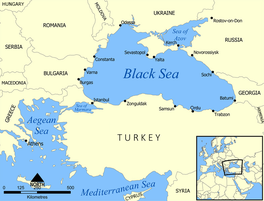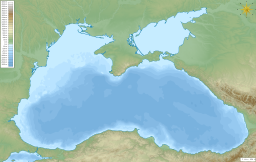
Back Амшын Еиқәа Abkhazian Хы ШӀуцӀэ ADY Swartsee Afrikaans Schwarzes Meer ALS ጥቁር ባሕር Amharic Mar Negra AN Euxinus ANG काला सागर ANP البحر الأسود Arabic ܝܡܐ ܐܘܟܡܐ ARC
| Black Sea | |
|---|---|
 The location of the Black Sea | |
 Map of the Black Sea with bathymetry and surrounding relief | |
| Location | Eastern Europe and West Asia |
| Coordinates | 44°N 35°E / 44°N 35°E |
| Type | Sea |
| Primary inflows | Sea of Marmara, Sea of Azov, Danube, Dnieper, Don, Dniester, Kuban, Black Sea undersea river |
| Primary outflows | Bosporus, Kerch Strait |
| Basin countries |
Unrecognised states: A large number of countries included in drainage basins for inflow rivers |
| Max. length | 1,175 km (730 mi) |
| Surface area | 436,400 km2 (168,500 sq mi) |
| Average depth | 1,253 m (4,111 ft) |
| Max. depth | 2,212 m (7,257 ft) |
| Water volume | 547,000 km3 (131,200 cu mi) |
| Islands | 10+ |





The Black Sea is a marginal mediterranean sea lying between Europe and Asia, east of the Balkans, south of the East European Plain, west of the Caucasus, and north of Anatolia. It is bounded by Bulgaria, Georgia, Romania, Russia, Turkey, and Ukraine. The Black Sea is supplied by major rivers, principally the Danube, Dnieper and Dniester. Consequently, while six countries have a coastline on the sea, its drainage basin includes parts of 24 countries in Europe.[1]
The Black Sea, not including the Sea of Azov, covers 436,400 km2 (168,500 sq mi),[2] has a maximum depth of 2,212 m (7,257 ft),[3] and a volume of 547,000 km3 (131,000 cu mi).[4] Most of its coasts ascend rapidly. These rises are the Pontic Mountains to the south, bar the southwest-facing peninsulas, the Caucasus Mountains to the east, and the Crimean Mountains to the mid-north. In the west, the coast is generally small floodplains below foothills such as the Strandzha; Cape Emine, a dwindling of the east end of the Balkan Mountains; and the Dobruja Plateau considerably farther north. The longest east–west extent is about 1,175 km (730 mi).[5] Important cities along the coast include (clockwise from the Bosporus) Burgas, Varna, Constanța, Odesa, Sevastopol, Novorossiysk, Sochi, Poti, Batumi, Trabzon and Samsun.
The Black Sea has a positive water balance, with an annual net outflow of 300 km3 (72 cu mi) per year through the Bosporus and the Dardanelles into the Aegean Sea.[6] While the net flow of water through the Bosporus and Dardanelles (known collectively as the Turkish Straits) is out of the Black Sea, water generally flows in both directions simultaneously: Denser, more saline water from the Aegean flows into the Black Sea underneath the less dense, fresher water that flows out of the Black Sea. This creates a significant and permanent layer of deep water that does not drain or mix and is therefore anoxic. This anoxic layer is responsible for the preservation of ancient shipwrecks which have been found in the Black Sea, which ultimately drains into the Mediterranean Sea, via the Turkish Straits and the Aegean Sea. The Bosporus strait connects it to the small Sea of Marmara which in turn is connected to the Aegean Sea via the strait of the Dardanelles. To the north, the Black Sea is connected to the Sea of Azov by the Kerch Strait.
The water level has varied significantly over geological time. Due to these variations in the water level in the basin, the surrounding shelf and associated aprons have sometimes been dry land. At certain critical water levels, connections with surrounding water bodies can become established. It is through the most active of these connective routes, the Turkish Straits, that the Black Sea joins the World Ocean. During geological periods when this hydrological link was not present, the Black Sea was an endorheic basin, operating independently of the global ocean system (similar to the Caspian Sea today). Currently, the Black Sea water level is relatively high; thus, water is being exchanged with the Mediterranean. The Black Sea undersea river is a current of particularly saline water flowing through the Bosporus Strait and along the seabed of the Black Sea, the first of its kind discovered.[citation needed]
- ^ ""Black Sea Geography, Oceanography, Ecology, History"". Archived from the original on 22 February 2018. Retrieved 18 February 2018. Living Black Sea
- ^ "Black Sea Geography". University of Delaware College of Marine Studies. 2003. Archived from the original on 7 April 2014. Retrieved 3 April 2014.
- ^ Maximum depth—"Europa – Gateway of the European Union website". Environment and Enlargement – The Black Sea: Facts and Figures. Archived from the original on 14 November 2008.
- ^ Murray, J. W.; Jannasch, H. W.; Honjo, S; Anderson, R. F.; Reeburgh, W. S.; Top, Z.; Friederich, G. E.; Codispoti, L. A.; Izdar, E. (30 March 1989). "Unexpected changes in the oxic/anoxic interface in the Black Sea". Nature. 338 (6214): 411–413. Bibcode:1989Natur.338..411M. doi:10.1038/338411a0. S2CID 4306135.
- ^ World and Its Peoples. Marshall Cavendish. 21 July 2010. p. 1444. ISBN 978-0-7614-7902-4 – via Internet Archive.
Black Sea 1175 km east west.
- ^ Miladinova, S.; Stips, A.; Garcia-Gorriz, E.; Macias Moy, D. (July 2017). "Black Sea thermohaline properties: Long-term trends and variations". Journal of Geophysical Research: Oceans. 122 (7): 5624–5644. Bibcode:2017JGRC..122.5624M. doi:10.1002/2016JC012644. ISSN 2169-9275. PMC 5606501. PMID 28989833.